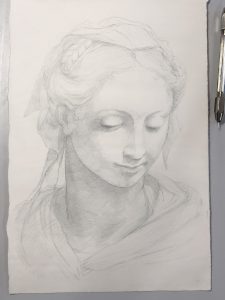Metalpoint drawing as practiced by Master Artists of 15th - 17th Centuries
The practice of metal point drawing dates back to antiquity. In Europe from the 14th century to 17th century Metalpoint was the popular medium for drawing. Each of the metals or alloys possess different physical characteristics, each metal giving a different type of stroke with subtle difference in hue also.
In order for the metalpoint to create an clear flowing line, the paper or parchment requires to be carefully prepared. Ceninno Ceninno in the late 14th century describes preparing the surface with crushed chicken bones, chalk or white lead. As the metal is drawn across the surface, tiny particles of metal are left behind, creating a mark. Often the paper would also be given a pale tint created by mixing earth pigments with a little animal glue, this also gave the possibility of creating highlights with the addition of white.

By the 15th century silver became the most popular metal to use for this technique, artists made use of the natural tarnishing qualities of the metal, resulting in the line becoming slightly darker with age. Other metals used were tin, bismuth, lead, gold and copper.
During this workshop students will be taken through a range of exercises using silverpoint. students will learn how to prepare their own traditional grounds for silverpoint drawing as described by Cennino Cennini using ground bones and chalk. Students will prepare a range of different coloured surfaces onto which they will make studies from old master drawings as well as creating their own subjects, exploring the possibilities of this beautiful technique and their use on coloured grounds.
The workshop will be held in the Tower studio within the ruins of Cowdray Castle, Midhurst, West Sussex
The fee for this five day workshop is £495.00
